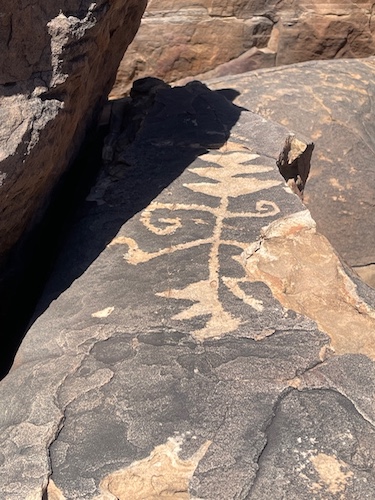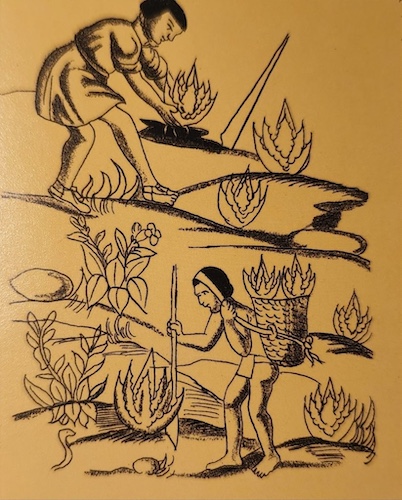 Petroglyph depiction of an agave plant – photo courtesy of Carlos Martinez del RíoThe Gila Native Plant Society has invited biologist Carlos del Río to give a talk at its evening program on Friday, April 18, 2025. Carlos is calling his presentation "Pollination, fermentation, and distillation: The biocultural co-evolution of mezcales, bats, and humans."
Petroglyph depiction of an agave plant – photo courtesy of Carlos Martinez del RíoThe Gila Native Plant Society has invited biologist Carlos del Río to give a talk at its evening program on Friday, April 18, 2025. Carlos is calling his presentation "Pollination, fermentation, and distillation: The biocultural co-evolution of mezcales, bats, and humans."
As Carlos explains, bats and agave plants (or mezcales) have interacted for several million years. Their interaction has led to the diversification of both and to the very peculiar biological characteristics of bats and agaves. The morphology and physiology of bats reflects their reliance on nectar for carbohydrates and pollen for protein. The once-in-a lifetime sexual reproduction of agaves that requires huge carbohydrate storage was shaped by bat pollination.
Humans took advantage of this outcome of the ancient interaction of bats and agaves and for many thousands of years have become reliant on mezcales for fiber, food and intoxicating beverages. They have also transformed many agave species by domesticating them.
Mesoamerican cultures have been deeply influenced directly by mezcales, and hence indirectly by bats. Pulque, the mildly alcoholic fermented drink favored by the Nahuatl inspired the development of strong distillates with methods borrowed from the Old World. These drinks are experiencing a worldwide boom that is placing bats, agaves and mezcal cultures in danger. What can we do to protect them?
Carlos Martinez del Río was born in Mexico and grew up in a cattle ranch in Northern Mexico surrounded by cattle dung and books. He received a Bachelor's Degree in Biology (with a minor in Math) from the Universidad Autónoma de México and a Ph.D. from the University of Florida. He taught and did research at Princeton, the University of Arizona and the University of Wyoming. He has spent his life studying the animals that pollinate flowers and/or disperse seeds. His research subjects (or rather, partners) include hummingbirds, nectar-feeding bats, hawkmoths, saguaros, mistletoes and phainopeplas. In 2022 he retired from teaching and moved to Silver City. He still does research on hummingbirds migrating through the Mimbres valley and on the molecules that allow hummers to digest and metabolize sugars. The rest of the time he indulges in his disorganized but passionate biophilia by hiking and riding his mule, Susana, throughout the Gila ecosystem.
 Agave gatherers from the Florentine Codex The program will be hybrid – in person and via Zoom – on Friday, April 18th, at 7:00 pm. All are welcome. To hear Carlos's talk, come to Harlan Hall, Room 111, on the WMNU campus at the corner of 12th and Alabama Streets in Silver City. Those who prefer to attend online may request a Zoom link from
Agave gatherers from the Florentine Codex The program will be hybrid – in person and via Zoom – on Friday, April 18th, at 7:00 pm. All are welcome. To hear Carlos's talk, come to Harlan Hall, Room 111, on the WMNU campus at the corner of 12th and Alabama Streets in Silver City. Those who prefer to attend online may request a Zoom link from
The Gila Native Plant Society is committed to promoting education, research and appreciation of the native flora of the Southwest; encouraging the preservation of rare and endangered plant species; and supporting the use of suitable native plants in landscaping. For information on programs, publications and membership, please visit www.gilanps.org.









